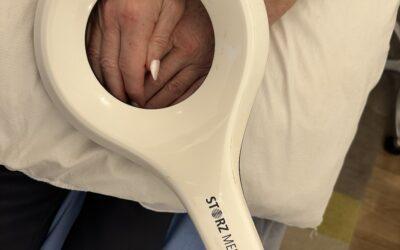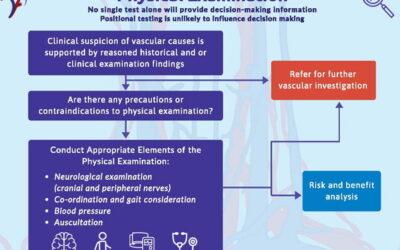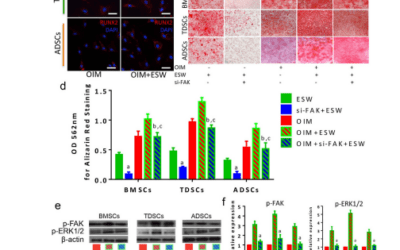Eswt Myofascial painEswt Myofascial pain
Abstract: In recent years, extracorporeal shock wave therapy (ESWT) has received increasing atten- tion for its potential beneficial effects on various bone and soft-tissue pathologies, yielding promising outcomes for pain relief and functional recovery. In fact, ESWT has emerged as an alternative, non-invasive, and safe treatment for the management of numerous musculoskeletal disorders, in- cluding myofascial pain syndrome (MPS). In particular, MPS is a common chronic painful condition, accounting for the largest proportion of patients affected by musculoskeletal problems. Remarkably, sensory innervation and nociceptors of the fascial system are emerging to play a pivotal role as pain generators in MPS. At the same time, increasing evidence demonstrates that application of ESWT results in selective loss of sensory unmyelinated nerve fibers, thereby inducing long-lasting analge- sia. The findings discussed in the present review are supposed to add novel viewpoints that may further enrich our knowledge on the complex interactions occurring between disorders of the deep fascia including changes in innervation, sensitization of fascial nociceptors, the pathophysiology of chronic musculoskeletal pain of MPS, and EWST-induced analgesia. Moreover, gaining mechanistic insights into the molecular mechanisms of pain-alleviating effects of ESWT may broaden the fields of shock waves clinical practice far beyond the musculoskeletal system or its original application for lithotripsy.
Keywords: extracorporeal shock wave therapy (ESWT); fascial innervation; nociceptors; pain relief effect; musculoskeletal disorders; myofascial pain syndrome (MPS)
1. Introduction
In the last decades, extracorporeal shock wave therapy (ESWT) has emerged as an alternative to surgery, as a non-invasive therapeutic approach for the management of various musculoskeletal disorders affecting both the lumbar region and upper and lower limbs [1].
Being at first introduced in the 1980s into routine clinical practice for treating uri- nary stones (lithotripsy) [2,3], its application has rapidly expanded across a wide range of medical specialties, yielding promising outcomes for bones and soft tissues healing, pain relief, and functional recovery. Due to the negligible side effects, which only relate to minor referred pain during ESWT sessions and minor hematoma, this therapy repre- sents a safe, advantageous, and well-tolerated approach without surgical risks or severe complications. Therefore, the use of ESWT has gained increasing popularity for treating different musculoskeletal disorders. These encompass tendinopathies (both calcifying and non-calcifying), plantar fasciitis (PF), lateral epicondylitis (“tennis elbow”), greater
Department of Translational Research and New Technologies in Medicine and Surgery, University of Pisa, Via Roma 55, 56126 Pisa, Italy; gabriele.morucci@unipi.it (G.M.); gianfranco.natale@unipi.it (G.N.); paola.soldani@unipi.it (P.S.); marco.gesi@unipi.it (M.G.)
Center for Rehabilitative Medicine “Sport and Anatomy”, University of Pisa, 56121 Pisa, Italy
Museum of Human Anatomy “Filippo Civinini”, University of Pisa, 56126 Pisa, Italy * Correspondence: larisa.ryskalin@unipi.it
Citation: Ryskalin, L.; Morucci, G.; Natale, G.; Soldani, P.; Gesi, M. Molecular Mechanisms Underlying the Pain-Relieving Effects of Extracorporeal Shock Wave Therapy: A Focus on Fascia Nociceptors. Life 2022,12,743. https://doi.org/ 10.3390/life12050743
Academic Editor: Nicola Maffulli
Received: 15 April 2022 Accepted: 15 May 2022 Published: 17 May 2022
trochanteric pain syndrome, bone nonunion fractures, and joint diseases including avas- cular necrosis [4]. In orthopedics, ESWT has demonstrated encouraging results in the treatment of pathological neo-calcifications. Several studies reported a complete or partial disintegration/fragmentation of calcification, pain relief, and a significant improvement of shoulder joint movement in patients with calcifying tendinitis following ESWT [5–9]. Of note, no recurrence of calcium deposits was observed during the two years follow- ing ESWT [10]. Moreover, strong evidence supports the use of low-energy ESWT in the treatment of pain-related tendinopathies such as chronic plantar fasciitis [11–13].
Although the precise molecular mechanisms of shock waves are still largely unknown, increasing evidence indicates that the application of ESWT to the locomotor system may sort various beneficial effects, which are way beyond a mere mechanical disintegrative effect, as generally assumed. These include increased perfusion, neo-angiogenic effects, osteogenesis, and fibroblastic stimulation [14–19]. Moreover, recent publications indicate that ESWT intervention has positive effects in reducing cellular inflammation [20,21]. Ex- perimental findings demonstrate that shock waves modulate macrophage activity, reduce leukocyte infiltration, and regulate cytokine and chemokine production [22–24]. Further- more, shock waves can promote tissue-repairing effects and regeneration by regulating stem cell activities within bones and soft tissues [25–28].
In addition to the aforementioned cellular and molecular mechanisms induced by shock waves, the pain-relieving effect is the most intriguing one. A number of randomized controlled trials (RCTs) showed that ESWT can effectively relieve pain in chronic PF that has been refractory to other common nonoperative modalities [29,30]. Therefore, currently, there is an increasing interest in ESWT application as a therapeutic alternative for multiple acute and chronic musculoskeletal pain conditions including myofascial pain syndrome (MPS) [31–33], defined as a painful disorder characterized by the presence of hyperirritable palpable nodules in the skeletal muscle fibers or the muscle fascia known as myofascial trigger points (MTrPs) [34,35]. MPS, both in acute and chronic form, represents one of the most common disabling musculoskeletal pain syndromes [33,36,37]. Remarkably, referred pain and/or increased pain sensitivity associated with MTrPs constitute the leading criteria to establish a diagnosis of MPS. In addition, dorsal horn sensitization is emerging as a key player in continuous pain of a specific body region as occurring in MPS [38]. Patients affected by MPS suffer from local muscle pain and referred pain originating from the surrounding fascia; this, in turn, reduces the range of motion, inducing muscle weakness and disability, thereby negatively impacting the quality of life. Therefore, pain relief and functional improvement, represent primary endpoints for most of the current therapies, which include both invasive and non-invasive techniques (i.e., dry needling, ultrasound, stretching, massage, taping) [39–44]. Nonetheless, it should be noted that most of the prescribed interventions for MPS show limited effectiveness in alleviating pain, which often persists or even worsens over time [45]. By contrast, a growing body of evidence demonstrates that long-term analgesia, lasting between several months and years, occurs following a couple of ESWT sessions [31,35,46–50].
Various hypotheses have been proposed on the molecular mechanisms by which ESWT alleviates pain in the musculoskeletal system [47,48,51–54]. A hypothesis is that ESWT can alter pain transmission by reducing the release of the pain-related neuropeptide substance P (SP) and other pain mediators from the treated area [52,55]. Furthermore, selective destruction of sensory unmyelinated fibers within the focal zone of shock wave application has shown to play a pivotal role in mediating ESWT-induced long-lasting analgesia [56]. Other authors speculated that dispersion of calcitonin gene-related peptide (CGRP) from degenerated sensory nerve fibers induces neurogenic inflammation preventing local re- innervation [47,48,51].
In this regard, it is worthy of mentioning that compared to the underlying muscles, the fascial tissue shows a greater innervation with multiple sensory nerve fibers including those with nociceptive capability [57–59]. Thus, the fascial system is recently, though
Life 2022, 12, x FOR PEER REVIEW Life 2022, 12, 743
3 of 20
3 of 19
gradually, emerging as a major contributor in the pathogenesis of musculoskeletal pain and dysfunctions including MPS [58,60–64].
gradually, emerging as a major contributor in the pathogenesis of musculoskeletal pain
Therefore, in the present review, after providing an overview on the molecular
and dysfunctions including MPS [58,60–64].
mechanisms underlying the beneficial effects of ESWT on the musculoskeletal system, we
Therefore, in the present review, after providing an overview on the molecular mecha-
discuss the complex relationship between pain in MPS and deep fascia alterations and the
nisms underlying the beneficial effects of ESWT on the musculoskeletal system, we discuss
possible molecular mechanisms underlying pain-alleviating effects of EWST, with a focus
the complex relationship between pain in MPS and deep fascia alterations and the possible
on fascial sensory nerve fibers and pain receptors.
molecular mechanisms underlying pain-alleviating effects of EWST, with a focus on fascial sensory nerve fibers and pain receptors.
2. Physiology and Biology of ESWT
2. Physiology and Biology of ESWT
2.1. Mechanism of Action: Technical Aspect
2.1. Mechanism of Action: Technical Aspect
ESWT consists of biphasic pulsed acoustic waves generated extracorporeally, which
ESWT consists of biphasic pulsed acoustic waves generated extracorporeally, which
carry energy and propagate in three dimensions through the tissue to induce a rapid
carry energy and propagate in three dimensions through the tissue to induce a rapid in-
increase in pressure [65]. In particular, shock waves consist of rapidly rising positive
crease in pressure [65]. In particular, shock waves consist of rapidly rising positive pressure pressure impulses ranging from 5 MPa up to 120 MPa in 5 ns, followed by a negative
impulses ranging from 5 MPa up to 120 MPa in 5 ns, followed by a negative pressure of
pressure of about −20 MPa [66]. Both the positive and negative phases induce
about −20 MPa [66]. Both the positive and negative phases induce physical/mechanical physical/mechanical effects on treated tissues (such as absorption, reflection, refraction,
effects on treated tissues (such as absorption, reflection, refraction, cavitation) [21,67], fol- cavitation) [21,67], followed by various molecular and biological effects, due to mechano-
lowed by various molecular and biological effects, due to mechano-transduction. In fact,
transduction. In fact, ESWT can trigger the activation of numerous cell signaling
ESWT can trigger the activation of numerous cell signaling pathways, as well as the release
pathways, as well as the release of several biomolecules [17,20,21].
of several biomolecules [17,20,21].
2.2. Types of ESWT: Focused vs. Radial Extracorporeal Shock Waves
2.2. Types of ESWT: Focused vs. Radial Extracorporeal Shock Waves
In clinical practice, two different types of ESWT are used, namely focused shock
In clinical practice, two different types of ESWT are used, namely focused shock
wave therapy (fESWT) and radial shock wave therapy (rESWT), which differ in the types
wave therapy (fESWT) and radial shock wave therapy (rESWT), which differ in the types
of devices used for the application. fESWT includes focusing devices (electro-hydraulic,
of devices used for the application. fESWT includes focusing devices (electro-hydraulic,
piezo-electric, electro-magnetic flat, electro-magnetic cylindric), while rESWT consists of
piezo-electric, electro-magnetic flat, electro-magnetic cylindric), while rESWT consists of
radial (ballistic) devices. In detail, fESWT produces a focused wave in a small focal area
radial (ballistic) devices. In detail, fESWT produces a focused wave in a small focal area
of 2–8 mm diameter, thus generating the maximum of energy flux density (EFD) in an
of 2–8 mm diameter, thus generating the maximum of energy flux density (EFD) in an
egg-shaped focal zone at a determined depth of the tissue. By contrast, the ballistic source
egg-shaped focal zone at a determined depth of the tissue. By contrast, the ballistic source
of rESWT results in a non-focused wave, which dissipates radially at the skin, reaching
of rESWT results in a non-focused wave, which dissipates radially at the skin, reaching
maximal pressure at the source [65]. Thus, focused shock waves (fSW) are concentrated
maximal pressure at the source [65]. Thus, focused shock waves (fSW) are concentrated on on a restricted area of the body and can penetrate deeper into the tissue, whereas radial
a restricted area of the body and can penetrate deeper into the tissue, whereas radial shock
shock waves (rSW) are more superficial; thus, rSW are generally used to treat wider areas
waves (rSW) are more superficial; thus, rSW are generally used to treat wider areas of the
of the body [21] (Figure 1). Nonetheless, much of current orthopedic research is focused
body [21] (Figure 1). Nonetheless, much of current orthopedic research is focused on the on the application of focused shock waves on the musculoskeletal system [1].
application of focused shock waves on the musculoskeletal system [1].
Figure 1. Physical characteristics and wave propagation of fESWT and rESWT. fESWT produces a Figure 1. Physical characteristics and wave propagation of fESWT and rESWT. fESWT produces a
high-energy shock wave that is concentrated onto a restricted, focused area of the body at a selected
high-energy shock wave that is concentrated onto a restricted, focused area of the body at a selected
depth of the tissue. Thus, this type of shock wave is particularly effective for the deepest tissues (up
depth of the tissue. Thus, this type of shock wave is particularly effective for the deepest tissues (up
ttoo1122ccmdeeepffrromttheessurrffacceeofftthe body)),,wheerreeiittgeneerraatteessttheemaaxxiimaalleenneerrggyyfflluxxdeenssitityy
((EFD))..Bycconttrraasstt,,rrSEWTprroducceessa non–ffoccusseedllow–eenneerrggyysshoocckkwaavveetthaattexpaandssrraadiiaalllyy from the skin surface. This, in turn, generates a shock wave with the highest pressure at the source,
from the skin surface. This, in turn, generates a shock wave with the highest pressure at the source, while it gradually weakens as it penetrates deeper into the tissue. Therefore, compared to fESWT, rESWT is generally used to treat wider and more superficial areas of the body.
Life 2022, 12, 743
4 of 19
In addition, compared with fESWT generators, rESWT devices



